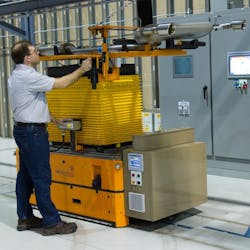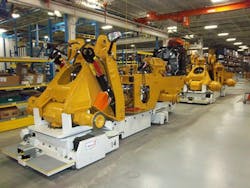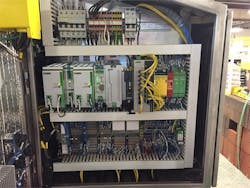How wireless communication is or isn't being used by machine builders
Dave Perkon is technical editor for Control Design. He has engineered and managed automation projects for Fortune500 companies in the medical, automotive, semiconductor, defense and solar industries.
Machines didn't used to talk much to the outside world, but strong interest in the Industrial Internet of Things (IIoT), Industry 4.0 and Smart Industry has and continues to change that. Wired communication to field I/O, machine-to-machine and the plant network is now common, but where does wireless fit in with machine builders, OEMs and system integrators?
There are many considerations when using wireless in a machine control or monitoring application. In some cases, it just has to be used due to application requirements; in other cases, it could be used but isn't. Fears, realities and lack of need for wireless connectivity reduces usage in yet other cases. In most cases, end-user interest, best practices and common, accepted and understood uses drive wireless applications as vendors continue to advance wireless hardware.
Wireless out of necessity
Some applications just require wireless and its flexibility. While wireless monitoring and control of tank farms, wastewater plants and other distributed processes are finding widespread use and acceptance due to the advantages, the machine side of wireless, especially for control, is moving slowly. Wireless remote monitoring and data analysis of machines are growing quickly, but wireless machine control is following a slow and conservative pace. However, some machine builders are seeing benefits to going wireless.
For example, RedViking, out of Plymouth, Michigan, has seen the need and benefits of going wireless. "One of the most important reasons is flexibility," notes Alfredo Flores, senior control engineer at RedViking. "Our customers have flexible manufacturing, and the machines we build for them have to be flexible. Wireless gives flexibility to have access to data at all times, regardless of the machine’s location, operating mode or accessibility."
In the past, RedViking predominantly used wireless for data acquisition in tracking and traceability systems where getting data “at some point” was acceptable. That’s not enough today. "The machine builder and end user want real-time data," comments Flores. "Sending and receiving real-time data using wired communication can be tricky, especially across safety zones and on machines that rotate or travel. Wireless communication can send and receive data to machines anywhere within the factory."
RedViking has seen the benefits of wireless communication's scalability. "It’s easier to expand data communication to additional machines when you don’t have to add wiring infrastructure," says Flores. "It’s also less expensive to install and maintain, and it requires less floor space."
The need for data
RedViking designs and builds pretty much anything that goes inside a factory—information infrastructure, custom machines and automation, conveyance and turnkey assembly lines. "Virtually all of our work incorporates data communication,” says Flores. “All of our primary markets, including aerospace, automotive, off-highway and defense, require it."
Figure 1: Low-frequency radio signals are used to synchronize the AGV with an overhead conveyor.
Source: RedViking
Any data that would typically be presented to a SCADA- or MES-level solution would also be available to wireless. "It used to be that wireless was only reliable enough for data acquisition," notes Flores. "But today our customers use wireless for bidirectional communication—collecting tracking and traceability data, error proofing, factory information systems, management reporting, remote diagnostics and real-time machine control. Much of the data communication can be wireless."
Also read: How secure is wireless communication?
In general terms, just add a transmitter and receiver, but in reality, the hardware architecture depends on the application. A wireless architecture example is a numerically controlled drilling machine RedViking built for an aircraft manufacturer, where Ethernet industrial protocol (Ethernet IP) communication over an industrial wireless network was used. In this case, it used Siemens IWLAN solution with SCALANCE access points, client modules and RCoax antennas. No special software is required other than for configuring the devices.
"This aerospace drilling system loads a drilling program from a centralized main computer based on where each individual drilling machine is located on the line," comments Flores. “The main computer loads a different program for each drilling machine, and each machine reports back MES data. Another example is our Wingspan battery-free automated guided vehicles (AGVs), which supports different protocols to fit the customer’s standards. We use Conductix-Wampfler IDAT communication modules that transfer RS-485 through a low-range field of radio frequency." Radio-frequency wireless control of the AGV and integrated lift allows synchronization with an overhead conveyor (Figure 1). The battery-free AGV receives commands from a master control and can report its position and status from any place in the line.
Future necessity
Like many of the new and developing technologies of today, wireless is being driven by the age of the manufacturing workforce as much as anything else. Although not widely adopted for machine control, wireless use will become more of a necessity.
"As the baby-boomer operators retire en masse, they’re being replaced by workers who are universally comfortable with mobile devices," comments Flores. "The younger workforce brings much higher expectations for user experience, expecting all interfaces to perform as intuitively as their non-work mobile apps." While yesterday’s operations manager is comfortable with jumping in the car to handle a second-shift bottleneck, tomorrow’s manager will want to see it all on the smartphone from the living room.
"For the most part we implement WLAN with IEEE 802.11 standards to communicate Ethernet IP, since most industry devices are compatible with it," notes Flores. "Current IEEE 802.11n standards are used heavily in industrial environments. They have common protocols and are supported by the majority of the wireless devices. In the future, we’ll be implementing longer and wider Wingspan lines, where each AGV can continuously send and receive data as it moves through multiple buildings (Figure 2). Typically our customers use a 200-m assembly line, but we’re working on lines that can be 10 times bigger and move in and out of factory buildings. All of the AGV communication will be wireless."
Figure 2: Wireless is a design necessity in this large-scale AGV assembly line.
Source: RedViking
Another future challenge is to integrate lower-range wireless networks that are reliable for control and can be integrated in a manufacturing facility without the risk of having any interference with the existing WLAN or IWLAN networks. "We'd like to see a protocol that is as supported, robust and as common as 802.11 but that doesn’t interfere with already existing IWLAN networks," comments Flores. "We never use Bluetooth, for example, because of its very limited range. A protocol with a greater range that is outside of common industrial network protocol’s radio frequency would allow our customers greater flexibility and scalability, especially if they guard their bandwidth very closely."
Wireless fears
"Data security was a fear for a long time, but that has been addressed to the comfort of our customers," states Flores. "I think wireless is robust enough to use for machine control and safety monitoring. There are multiple devices in the industry that are rated to transmit safety signals via wireless and meet safety standards. One of the challenges in wireless has been security, but new technology, when correctly engineered, can protect all of the machines on our customers’ wireless networks. A safe, secure network has to be engineered from the start. Using the correct devices, you can protect your network very well."
David Locke, founder of Control-Works in St Charles, Illinois, views wireless in a similar light. "I see wireless providing an easy way to distribute I/O across a machine or especially a plant-wide conveyor line," he notes. "As is the case with all networks, the security aspect will require firewalled, secured and isolated machine control networks for the best conveyor control."
Locke is looking into using wireless on a large product line. "A wireless interface back to a supervisory system is useful. However, I don't see an iPad or tablet being useful on a single piece of machinery as control should be done at the equipment. Monitoring machinery and collecting data is the wireless future."
In Locke's opinion, wireless is not ready for real-time control. "I just don't see wireless in deterministic control, but it's being done. It is not a high-speed method of monitoring I/O. I can see it in process and simple Bluetooth applications, but wireless control of I/O from a PLC or in a safety application, I don't trust it."
Prove it reliable and they will come
Until the vendors get out on the street and show that wireless control will work in machine or conveyor control, wired connections will remain popular. "Show me it's a proven technology," states Locke. "I have worked with wireless RF applications, and it is reliable. It's used on cranes all the time. What makes that reliable is a more proven technology—one that's been around for 50 years."
If the wireless network works as well as a wired one, there is no stopping wireless use. "Powerlink, Profisafe, Ethercat and many other wired networks are deterministic and are used in safety applications,” notes Locke. “If wireless is proven as reliable as wired networks, I can see wireless machine control being feasible. However, not on the plant wireless network; it will be on its own wireless control network."
On a conveyor line, wireless will have an immense value. Sensors along several positions still need power. "Wire 24 Vdc or 120 Vac to the sensor or it's a battery that can run out," says Locke. "It's really a power issue in some applications. It's not wireless if it needs power in a conveyor or similar application. I will be interested in a wireless sensor that generates power, from conveyor motion, to recharge a battery."
Wireless, if necessary
Wireless is great for sending information back and forth, but, when it comes to safety and control, many times its use is not even considered. "In our application, we may use wireless to request material replenishment or to acknowledge a fault by an operator who is moving around, but we haven't considered it for control applications," comments Rick Lamb, president at MidTechV, a technology-focused system integrator in Indianapolis. "The operator carries the button, so it is not necessary to move to a fixed location."
The Schneider Electric XB5R battery-less and wireless pushbutton doesn't require a battery because the pushbutton motion creates the energy. "Just train the button, or transmitter, to a receiver in the control panel," notes Lamb. "The range is maybe a couple hundred feet and repeater transmitters are available. In certain applications, this wireless pushbutton is a great timesaving option for an operator, but we only use it for non-critical functions."
Much of the wireless used on machine control is enabled due to the HMI. "The biggest use of wireless is on HMIs and tablets," comments Lamb. "Schneider's HMI is called Magelis, and it has a Web server built in. You can view it from anywhere when connected to a network, and it’s easy to configure. If you download an app, you can wirelessly view or control the HMI from a smartphone or tablet."
End-user interest
Many times, the use of wireless depends on the end user, but it also depends on whether other connection methods are available. "MidTechV developed a portable data logger, but nobody was interested in collecting the data wirelessly," says Lamb. "The early units used cellular modems, but nobody wanted to pay the cellular fees. We then set it up to work using wireless LAN, but users wouldn't take the time to connect to the wireless network." The users just carried the briefcase-size, portable data collection device to the machine, collected the data for a period of time and then just pulled the thumb drive, brought it to the computer and analyzed the data.
"The end users just cared about the data, but not wireless data,” comments Lamb. "There’s certainly interest in the data, but not much concern about how it’s obtained."
Non-wireless data
In a part-tracking, -traceability and -OEE application on a large automotive production line, the machines are staying wired. "We are networking 150 to 200 machines with no thought of going wireless," says Lamb. "MidTechV installed about 100 Ethernet adapters for PLCs and managed switches all wired into the customer's network. The custom and OEM machines, vision systems, robots and torque guns are all wired Ethernet. Everything has barcodes; everything is tracked; we collected more data than you could ever need; and the data is reliable."
There was a concern with going wireless by both MidTechV and the end user. "I don't think you want all that data flying around wirelessly," states Lamb. "With all the welding, machining, servos, motors and VFDs, you never know. In fact, the only wireless is the HMI iPads. Supervisors have them. They are displaying and analyzing data about how many parts were made, cycle times and faults, all by accessing the Oracle database in the sky via the plant wireless network."
The only other wireless used in this facility was for temporary use. "MidTechV was waiting on installation of the network cables during startup and testing," notes Lamb. "The programmers didn't want to wait, so temporary connections to the equipment were made, using wireless routers, and the system was tested. When the end user completed installation of the network cables, the wireless hardware was removed."
To highlight additional problems of wireless use, Lamb had another example application. "MidTechV developed test equipment for wireless-wheel air-pressure transmitters that are final-installed inside the tire. It was the worst wireless experience ever. The test system was designed to mimic the pressure receiver in an auto to test the transmitter in the tire. Due to space limitations, when you tried to talk to the wireless pressure transmitter, the box of 100 transmitters tried to answer at the same time. Shielding eventually corrected this problem but it also highlights a wireless flaw."
Cut the cable
Some wireless benefits include reduced downtime and savings. The future of wireless looks non-wired. "Wired connections are often considered more reliable than wireless; however, that is frequently not the case," notes Keith Blodorn, wireless director of program management at ProSoft Technology. "In applications that involve communication to moving equipment, hard-wired communication interfaces have often been a source of downtime. Methods such as slip rings, bus bars and festoons introduce mechanical wear as a factor in the communication system performance. Applied correctly, wireless technology offers a more reliable and robust alternative, often at a lower installed cost."
Wireless communication may present an opportunity to improve the machine’s reliability and reduce cost. "One of our OEM customers who makes packaging machines for the food and beverage industry identified the slip ring on its machines as a major source of downtime," comments Blodorn. However, the OEM was concerned about not having control over the RF environment of the end users and how other radio signals in those different plants would impact the machine. The solution for propagating the wireless data signals was to use a wireless system with radiating cable in place of a traditional antenna. The radiating cable provided the RF signal needed for the application, exactly where it was needed, with minimal interference issues outside the machine.
Another example of reliability and reduced downtime benefits can be connected to wireless use. "One thing that users don't always consider when comparing a wired vs. wireless solution is the time and money associated when the equipment is not running due to a broken cable," notes Justin Shade, wireless product marketing specialist at Phoenix Contact. It's important to analyze the cost associated with repairing a broken cable or the production lost when a machine is not working due to this failure, when considering a wireless solution, but wireless does have its issues.
"Just as the engineer must consider what happens if a cable is cut, working through the system response to a lost wireless connection is a must for successful applications," says Blodorn. "Wireless technology works well for time-synchronized networks, in applications where capturing an accurate sequence of events is important. However, for some applications, such as motion control over Ethernet, the latency and jitter associated with a wireless network compared to a wired network is simply too high for the application to go wireless. In the end, each engineer must weigh the benefits and capabilities of wireless for each application and determine the right solution."
Wireless standards
"The common wireless standards include cellular, Wi-Fi and Bluetooth," notes Dennis Fairfield, sales manager at HMS Industrial Networks. "I believe these will be the core technologies that will be developed with higher-layer security and safety mechanisms to satisfy the industrial requirements."
Cellular is convenient for machine builders and system integrators to remote-troubleshoot and update PLC logic without requiring access to the plant-floor network. "Wi-Fi is a wireless technology that exists in most plants already," comments Fairfield. "What may complicate this technology is that the IT department governs its use within a facility, making it subject to both plant-floor and business-level rules and regulations. Bluetooth is another option that is becoming more popular. With the IoT and bring-your-own-device technology, Bluetooth is becoming a very good tool to help operations focus on the manufacturing process."
New Wi-Fi based communications will allow faster throughput, as will faster, lower-cost communications from cellular providers. "We are actively developing and deploying industrial-grade routers based on the relatively new 802.11ac standard with an eye on the upcoming 802.11af/ah standards," notes Andrew Barco, product manager of network connectivity—North America, at Weidmüller. "These allow for greater throughput while using UHF bands to go through brick, mortar and some metals that are traditionally wireless inhibitors."
On the cellular side, as the FCC and IC associations auction off more frequencies and wider bands, not only does the carrier allow for better speeds, but it also brings down the cost for data as a key driver. Weidmüller already has routers ready for worldwide deployment that are able to communicate over the new-frequency Wi-Fi and cellular bands that are being deployed in many areas.
Wired reality of safety and control
Figure 3: The wireless module in this control panel helps control the lasers in an automated construction machine.
Source: Phoenix Contact
"When using a wireless system in a real-time network for control or safety, it is important to understand the limitations and have realistic expectations," notes Phoenix Contact’s Shade. "Typically, control and safety applications are done via hardwire for both speed and reliability (Figure 3). These types of applications have a high expectation of uptime and cannot afford to be down for any reason. It is possible to have a wireless system operate at a high performance level; however, with any wireless system, there are limitations."
There are latencies related to wireless technologies that aren’t present in a wire. "It is important to consider these latencies when designing a control or safety system to understand the limitation and decide whether that limitation is acceptable for your application," says Shade.
There is no question that wireless is becoming a valuable tool in automated equipment, and it does have its place in the overall scheme of things. "We are already in the area of real-time monitoring and control; however, safety has always had it caveats," comments Weidmüller’s Barco. "We have been involved with installations that involve safety, but in every system there are local safety relays that are constantly monitoring the link status between wireless devices."
Weidmüller has been using wireless control and safety in the mining industry for years. “As the bandwidth increases and safety protocols evolve, it is not inconceivable to see wireless safety systems used in automated OEM equipment in the near future," says Barco. As wireless systems evolve, wireless suppliers will be ready.
Popular uses
"What wireless brings to the table is the ability for the OEM to offer customers scalability and modularity in their equipment without the added worry of how to get the cells or machines to communicate with each other and without the expense of running multiple cables," notes Weidmüller’s Barco, who identifies four main areas where OEMs tend to use wireless technology, depending on the application.
Those four popular uses of wireless include:
- communication directly from controllers to I/O points
- communication between controllers or over Ethernet or bus control system
- HMI functional communication to smartphones and tablets
- remote access to the machine from anywhere in the world to facilitate troubleshooting or do programming/software updates.
Having the ability to communicate with machines from anywhere in the world is an area that is growing more rapidly than any other. It offers the OEM the ability to troubleshoot and commission automated equipment remotely and offer peace of mind to customers, should there be any hiccups in production.
"The benefits of having wireless connections to automation equipment are multifaceted," notes Ed Sandlin, industry business product marketing manager at Schneider Electric. "Wireless connectivity with your machines can aid in the reduction of service costs, maintenance costs and lost revenues associated with downed equipment. The ability to remotely interact with, visualize and maintain automation equipment can allow operations engineers to remotely diagnose problems, develop more precise maintenance schedules to minimize downtime and increase the efficient deployment of resources."
The best use of wireless is in an application and environment where it is properly specified, designed and installed. "Best practice for a wireless system is to have it isolated from all other RF in the local area,” comments Phoenix Contact’s Shade. "This will allow for peak performance and will cut down on the possibility of delays on the system. This can be done by planning out the wireless system, setting up different technologies in different areas, having each wireless system on a different channel so they don't overlap and working with your IT group to coordinate a cohesive approach to a complete wireless system."








